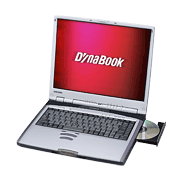The DynaBook DB70P/5MC A4-sized all-in-one notebook, announced in 2000, was the world’s first notebook computer with a CD-ROM, CD-R/RW, and DVD-ROM multidrive that could both play DVD media and write to CD-R/RW media.
With the growing digital audio player market and the prevalence of Internet music distribution, the market share of computers with built-in CD-R/RW drives was on the rise, as more and more computers were being used to edit, store, and play back music. There was also a nascent demand for models with built-in DVD-ROM drives to play back the growing number of DVD movie titles. Toshiba specifically developed the DynaBook DB70P/5MC as a notebook that met these new computing needs. In addition to the world’s thinnest 12.7 mm multidrive, it featured a high-fidelity stereo speaker system with a subwoofer to accentuate bass frequencies, a 15-inch TFT XGA-compatible SuperView LCD screen that was the brightest and largest notebook screen at the time, and an S3 Savage IX graphics accelerator.
The notebook offered excellent connectivity with audio and video devices thanks to a i.LINK (IEEE 1394) connector for video editing with a connected video camera and an S/PDIF optical digital output that could be easily connected to 5.1 surround sound speakers, MD recorders, and other audio equipment.
In keeping with the launch of commercial ADSL and cable Internet access services, the DynaBook DB70P/5MC came standard equipped with a LAN interface to support these new high-speed communication formats in addition to the functionality to support for conventional dial-up connections.
The notebook was powered by a 700 MHz mobile Pentium III processor that supported Intel’s SpeedStep technology. It came standard with 120 MB of PC100-standard high-speed SDRAM that was expandable up to 384 MB and a 20 GB hard drive. The DynaBook DB70P/5MC ran Microsoft Windows Millennium Edition (Windows Me) as its operating system.


